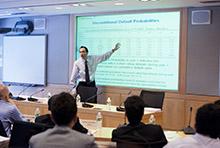
Typical street scene in Santa Ana, El Salvador. (Photo: iStock)
IMF Survey : IMF Launches Online Economics Learning for Global Classroom
June 19, 2013
- New IMF initiative to offer core economics training online
- edX e-learning platform to reach new audiences
- Positive reactions to interactive online learning pilots
In the virtual classroom of tomorrow, central bank and government officials will be able to supplement what they learn in physical IMF classrooms by tapping into an online network of economics and financial training courses.

The IMF will offer economics courses online to complement its face-to-face training, allowing the institution to reach much wider audiences (photo: IMF).
CAPACITY BUILDING
And courses that have thus far been restricted to IMF member country officials will be available to students, bankers—anyone who’s interested and has an internet connection.
Thanks to a new partnership with edX, the nonprofit online learning initiative founded by Harvard University and the Massachusetts Institute of Technology, the IMF will soon start offering economics courses online to officials from around the world to complement its traditional training delivery. Free public access, through so-called massive open online courses (MOOCs), will follow in 2014.
“Taking our training online opens up a whole world of possibilities,” said Sharmini Coorey, Director of the IMF’s Institute for Capacity Development, which runs training courses in economics and finance for officials from the IMF’s 188 member countries—mostly those working at central banks and finance ministries. Topics range widely, from economic policy and forecasting to financial stability, legal frameworks, and compiling official statistics. “Online learning not only means we can train our member countries officials better—it also means everyone can join in.”
Better understanding of key economic policy issues raises the level of public debate and can help positive policy reforms gain traction and support. Last year the IMF trained 7,800 officials from around the world to help them make better policies. But the same analytical skills are in demand in a host of other walks of life: academics, journalists, financial sector workers, legislators, civil society and labor organizations, to name but a few.
“In terms of the number of people we can reach, this is a game-changer,” Coorey said.
Learning by doing
The IMF has successfully experimented with e-learning on partial segments of courses in recent months. The modules developed thus far have been used to ensure participants are fully prepared before traveling for a face-to-face course at the institution’s Washington headquarters or one of its seven regional training centers around the world.
“It brings participants up to the same level, and saves precious time in the classroom,” said Ales Bulir, a Czech economist who lectures full-time for the IMF. “Time saved explaining the basic facts can be used for policy dialogue.”
Courses containing segments on designing fiscal frameworks for natural resource-rich countries, techniques to calculate the output gap, and the effects of monetary policy on the economy have already gone partly online, and more are set to follow. The online course segments include recorded clips of lectures and slideshows of data and graphics, interspersed with interactive multiple-choice quizzes and hands-on workshops. Participants download datasets and crunch the numbers themselves to ensure they have understood the macroeconomic analysis tools and to help them commit the lesson to memory. Their understanding is therefore tested more frequently and systematically than would be possible in a classroom setting. Wrong answers trigger a helpful hint, while correct answers prompt an explanatory phrase to reinforce the lesson.
“E-learning is really a mixture of lecture and workshop—learning becomes much more interactive and effective than in a straight lecture format,” Bulir said.
Hour-long classroom lectures are broken down into 10-minute segments for e-learning, since people’s attention spans online are significantly shorter than they are in the physical classroom. As a result, the segments tend to be more focused and structured than a conventional face-to-face lecture format.
“It’s a true disciplining device for the instructor,” Bulir said. “I cannot assume someone will be watching it in one block—someone will be knocking on the door, a phone may be ringing, kids may be calling dad for dinner, so I have to assume that each of these individual 5-10-minute videos is watched in isolation.”
Building blocks
Some subjects lend themselves more easily to online learning than others: for example, manipulating data to estimate the output gap—that is, the difference between what an economy could produce and what it is producing—can be broken down into step-by-step lessons more easily than a broader debate on finding the right policy mix to achieve a set of economic objectives. E-learning doesn’t spell the end of classroom-based training, but it opens up training in certain key economics skills to a mass audience.
“We are creating building blocks that can be dovetailed with other sections of training,” said Bulir, the lecturer.
Ray Brooks, head of the Europe and Middle East Division of the IMF’s Institute for Capacity Development, has experimented this year with e-learning modules within a physical classroom context.
“With e-learning, people are able to go at their own pace—and the counselors are still there to handle questions,” said Brooks, previously the IMF’s representative in China, as he scrolled through a course on an iPad. So far, feedback is positive: participants like the online format and the mix of tutorial and practical sessions. Many participants repeat online exercises until they achieve a higher score, reinforcing the learning experience through repetition.
What’s more, once they have online access, they dip back into the course weeks or months afterwards, refreshing their memories on specific sections of courses as they crop up in their real-life jobs. E-learning becomes more than a one-off course, Brooks said; it becomes almost a virtual coach.
“This innovative approach changes the way people learn,” he said.


